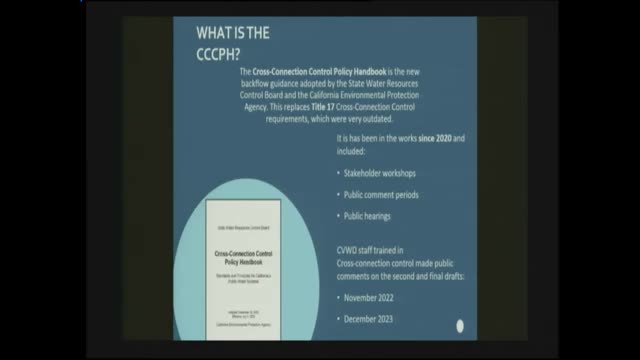USC initiates new backflow prevention requirements impacting local commercial properties
May 23, 2024 | Carpinteria City, Santa Barbara County, California

This article was created by AI summarizing key points discussed. AI makes mistakes, so for full details and context, please refer to the video of the full meeting. Please report any errors so we can fix them. Report an error »

In the heart of Carpinteria, city officials gathered on May 22, 2024, to discuss pressing water safety regulations that could impact local businesses and residents alike. The meeting, held at the Carpinteria Valley Water District, focused on new state guidelines regarding backflow prevention—a critical measure designed to protect the public water supply from contamination.
As the discussion unfolded, officials explained the concept of cross-connection, where water from non-public sources could inadvertently enter the public water system. This could occur through various means, such as industrial processes or even a drop in water pressure due to a main break. To combat these risks, the state has mandated the installation of backflow prevention devices for certain properties, particularly those with fire sprinkler systems installed within the last decade.
The implications of these regulations are significant. Up to 100 properties in the district may now be required to install backflow devices and undergo annual inspections. This requirement is particularly relevant for commercial properties with multiple units served by a single meter, as the water district cannot monitor changes in occupancy that might introduce new hazards.
One local business owner, who operates a quilting store and a hair salon in a multi-unit building, expressed concern over the new regulations. The owner argued that their current operations do not pose a risk, yet the guidelines necessitate a backflow device to safeguard against potential future hazards. This sentiment was echoed by other officials who questioned the rationale behind classifying certain business parks as high-hazard facilities without a clear understanding of the activities within.
The cost of compliance adds another layer of complexity. Installing a backflow device can cost around $3,000, with annual testing fees ranging from $100 to $500. These expenses could pose a financial burden for small businesses already navigating the challenges of a post-pandemic economy.
While the meeting highlighted the importance of protecting the water supply, it also raised questions about the practicality and fairness of the new regulations. Officials acknowledged the need for a more comprehensive approach to water safety, suggesting that the current guidelines may not adequately address the realities faced by local businesses.
As the Carpinteria Valley Water District moves forward with these changes, the community will need to adapt to ensure both public health and economic viability. The discussions at the meeting reflect a broader conversation about balancing safety with the needs of local businesses, a challenge that will continue to unfold in the coming months.
As the discussion unfolded, officials explained the concept of cross-connection, where water from non-public sources could inadvertently enter the public water system. This could occur through various means, such as industrial processes or even a drop in water pressure due to a main break. To combat these risks, the state has mandated the installation of backflow prevention devices for certain properties, particularly those with fire sprinkler systems installed within the last decade.
The implications of these regulations are significant. Up to 100 properties in the district may now be required to install backflow devices and undergo annual inspections. This requirement is particularly relevant for commercial properties with multiple units served by a single meter, as the water district cannot monitor changes in occupancy that might introduce new hazards.
One local business owner, who operates a quilting store and a hair salon in a multi-unit building, expressed concern over the new regulations. The owner argued that their current operations do not pose a risk, yet the guidelines necessitate a backflow device to safeguard against potential future hazards. This sentiment was echoed by other officials who questioned the rationale behind classifying certain business parks as high-hazard facilities without a clear understanding of the activities within.
The cost of compliance adds another layer of complexity. Installing a backflow device can cost around $3,000, with annual testing fees ranging from $100 to $500. These expenses could pose a financial burden for small businesses already navigating the challenges of a post-pandemic economy.
While the meeting highlighted the importance of protecting the water supply, it also raised questions about the practicality and fairness of the new regulations. Officials acknowledged the need for a more comprehensive approach to water safety, suggesting that the current guidelines may not adequately address the realities faced by local businesses.
As the Carpinteria Valley Water District moves forward with these changes, the community will need to adapt to ensure both public health and economic viability. The discussions at the meeting reflect a broader conversation about balancing safety with the needs of local businesses, a challenge that will continue to unfold in the coming months.
View full meeting
This article is based on a recent meeting—watch the full video and explore the complete transcript for deeper insights into the discussion.
View full meeting
